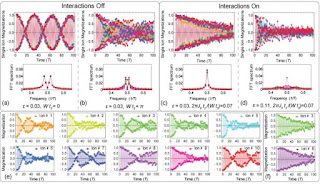 |
| Image Source: Technology Review |
Topics: Computer Science, Quantum Computer, Quantum Mechanics
TECHNOLOGY REVIEW: Time crystals were first predicted in 2012. Now researchers have created time crystals for the first time and say they could one day be used as quantum memories.
Crystals are extraordinary objects, not least because of their symmetry. Crystals form repeating patterns that are the same in some directions but not all directions. That’s something of a surprise given that the laws of physics, which govern their formation, are the same in all directions.
That the laws of physics are spatially symmetrical but crystals are not is a phenomenon known as symmetry breaking. It comes about not by adding energy to a system, but by taking it away. Indeed, crystals are a manifestation of systems in their lowest energy states.
But the laws of physics are not only symmetrical in space but also in time. And that raises the interesting question of whether it is possible to break temporal symmetry in the same way. In other words, is it possible to create time crystals?
Abstract
Spontaneous symmetry breaking is a fundamental concept in many areas of physics, ranging from cosmology and particle physics to condensed matter. A prime example is the breaking of spatial translation symmetry, which underlies the formation of crystals and the phase transition from liquid to solid. Analogous to crystals in space, the breaking of translation symmetry in time and the emergence of a "time crystal" was recently proposed, but later shown to be forbidden in thermal equilibrium. However, non-equilibrium Floquet systems subject to a periodic drive can exhibit persistent time-correlations at an emergent sub-harmonic frequency. This new phase of matter has been dubbed a "discrete time crystal" (DTC). Here, we present the first experimental observation of a discrete time crystal, in an interacting spin chain of trapped atomic ions. We apply a periodic Hamiltonian to the system under many-body localization (MBL) conditions, and observe a sub-harmonic temporal response that is robust to external perturbations. Such a time crystal opens the door for studying systems with long-range spatial-temporal correlations and novel phases of matter that emerge under intrinsically non-equilibrium conditions.
Physics arXiv: Observation of a Discrete Time Crystal
J. Zhang, P. W. Hess, A. Kyprianidis, P. Becker, A. Lee, J. Smith, G. Pagano, I.-D. Potirniche, A. C. Potter, A. Vishwanath, N. Y. Yao, C. Monroe
Comments